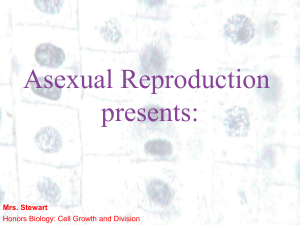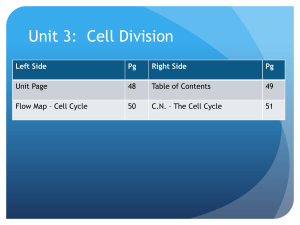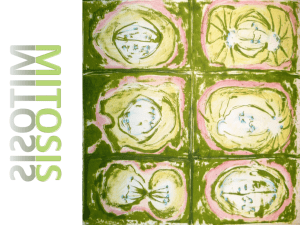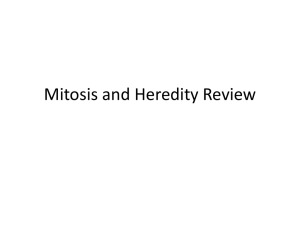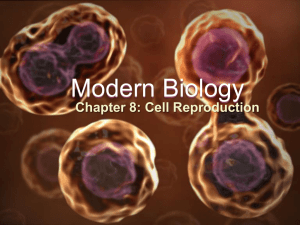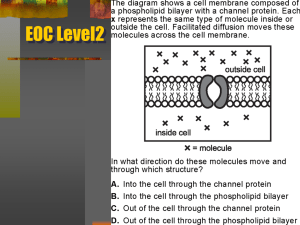2.5: CELL DIVISION
advertisement
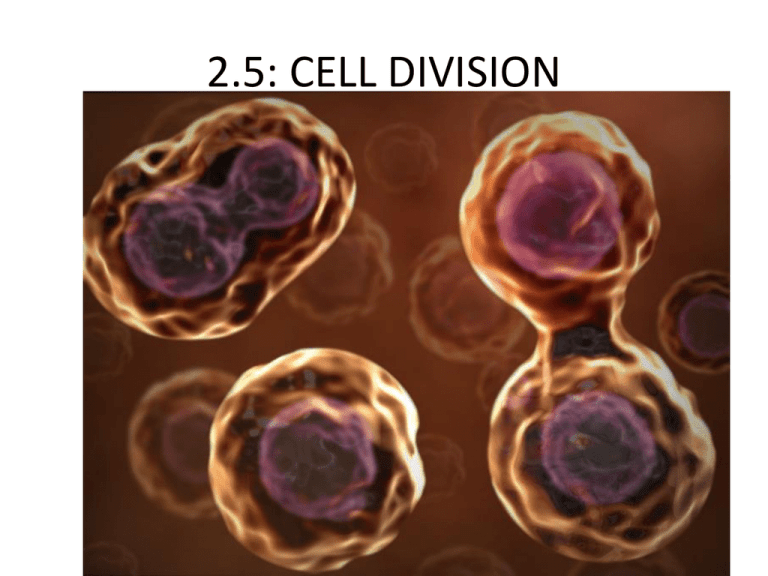
2.5: CELL DIVISION 2.5.1: Cell Cycle: Outline the stages of the cell cycle, including interphase (G1, S, G2), mitosis and cytokinesis Cytokinesis starting *During its life, a cell passes through a well-ordered series of events known as the cell division cycle. *The cell division cycle involves three basic stages: interphase, mitosis and cytokinesis. *Interphase is much longer than mitosis and it begins as soon as a daughter cell is formed. It is an active period during which: the cell grows; DNA transcription and DNA replication occur; and biochemical reactions are performed. Interphase is broken up into three stages: *G1 Stage (first growth stage) The cell performs its normal differentiated function. Protein synthesis mitochondria replication/ chloroplast replication. *S Stage DNA replication. At this point the mass of DNA in the cell has doubled. *G2 Stage (second growth stage) Preparation for cell division *Mitosis is a continuous process but it is useful to divide it into four stages: prophase, metaphase, anaphase, and telophase. During mitosis the nucleus divides into two daughter nuclei each with same the number of chromosomes as the parent nucleus. *Cytokinesis the cell separates its cytoplasm, organelles and DNA equally and pinching in of the plasma membrane to divide the cell into two equal daughter cells. Cytokinesis commences towards the end of mitosis. 2.5.2: STATE: Tumours (cancer) cells are the result of uncontrolled cell division and these can occur in any organ or tissue 2.5.3: STATE: Interphase is an active period in the life of a cell when many metabolic reactions occur, including protein synthesis, DNA replication and an increase in the number of mitochondria and / or chloroplasts Mitosis is division of the nucleus in which one parent nucleus divides into two daughter nuclei each having the same number of chromosomes as the parent nucleus. 2.5.4 and 2.5.5: Mitosis Supercoiling of chromosomes Nuclear membrane breaks down Spindle microtubles extend from pole to equator Microtubules attach to centromere line along equator of cell Chromosomes Centromere splits and sister Chromatids (now chromosomes) move to opposite poles Reformation of nuclear membrane around chromosomes Chromosomes uncoil STATE: Growth, embyonic development, tissue repair and asexual reproduction involve mitosis IB Question: Describe the events that occur during mitosis. [9] IB Question: Describe the events that occur during mitosis. [9] sequence of stages is prophase metaphase anaphase telophase; chromosomes condense/supercoil/become shorter and fatter in prophase; spindle microtubules grow (from poles to equator) in prophase/metaphase; nuclear membrane breaks down in prophase/metaphase; spindle microtubules attach to the centromeres/chromosomes in metaphase; chromosomes line up at equator in metaphase; centromeres divide / (paired) chromatids separate / chromosomes separate into two chromatids in metaphase/anaphase; (sister) chromatids/chromosomes pulled to opposite poles in anaphase; spindle microtubules disappear in telophase; nuclear membrane reforms around chromosomes/chromatids in telophase; chromosomes/chromatids decondense in telophase; [9 max] IB Question: Before cell division in unicellular and multicellular organisms, the nucleus must divide to produce two genetically identical nuclei. Explain the events that occur in cells that result in the production of genetically identical nuclei. [8] IB Question: Before cell division in unicellular and multicellular organisms, the nucleus must divide to produce two genetically identical nuclei. Explain the events that occur in cells that result in the production of genetically identical nuclei. [8] mitosis; DNA replication; each chromosome consists of two sister / identical chromatids; chromosomes condense / supercoiling; nuclear membrane breaks down; chromosomes align (at equatorial plate); spindle fibres / microtubules attach to centromeres of chromosomes on opposite sides; centromeres split; chromatids become chromosomes; sister / identical chromosomes pulled to opposite poles; nuclear membranes reform; events correctly assigned to interphase, prophase, metaphase, anaphase, and telophase; [8 max]


